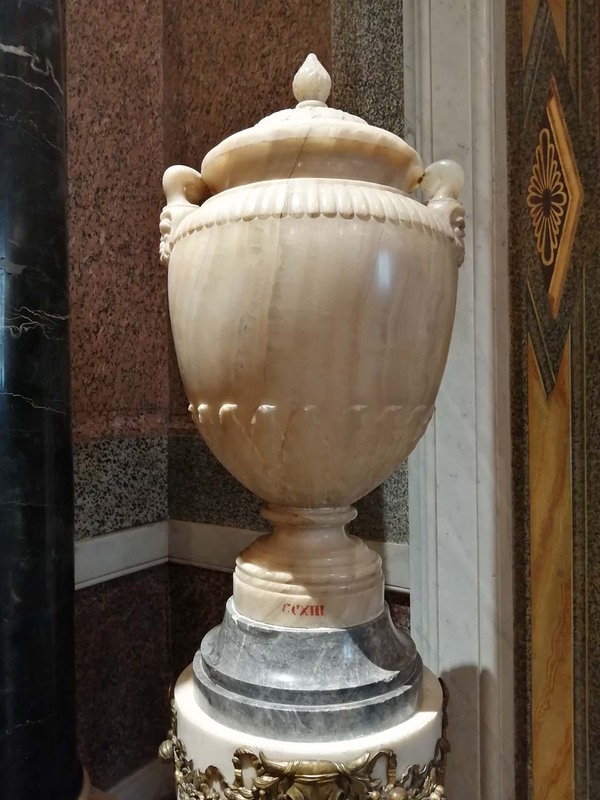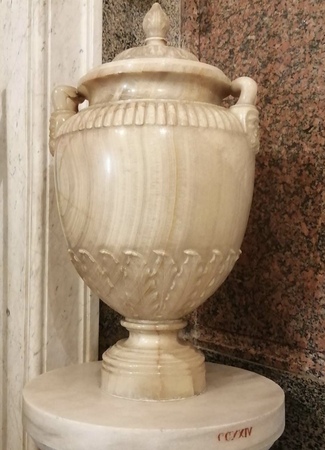Four Amphorae in Alabaster
This series of four amphorae in ‘cotognino’ alabaster was sculpted in the late 18th century by an unknown artist. The works were realised in the context of the renovation of Villa Pinciana carried out at the behest of Marcantonio IV Borghese and designed and directed by the architect Antonio Asprucci.
Each of the four elegant objects rests on a foot with circular moulding. Its ovoid body is decorated with leaf motifs in the lower portion and with pod designs in the upper. The two double handles emerge from the rim and are attached to the body at the height of the shoulder, where they are embellished with grotesque masks. The hemispherical lid is decorated with leaves and culminates in a knob with plant motifs.
The veining of the alabaster is clearly visible in the ovoid bodies of the amphorae. In addition to highlighting their beauty, the different patterns serve to distinguish the four objects, creating a series with pleasant variations.
Object details
Inventory
CCV-CCXIII-CCXVIII-CCXXIV
Location
Date
Classification
Period
Medium
Dimensions
Provenance
Documented at Villa Pinciana from 1796 (L. Lamberti, E.Q. Visconti, 1796, II, p. 98); Inventario Fidecommissario Borghese 1833, C, p. 49, no. 119. Purchased by Italian state, 1902.
Conservation and Diagnostic
- 1996/ 1998 L. Persichelli
Commentary
Sculpted in ‘cotognino’ alabaster, the amphorae are characterised by ovoid bodies. The lower portion of each is decorated with flattened leaves, while the shoulders show a motif of swollen pods, which is interrupted by grotesque masks where the lower end of the double handles are attached. The upper end of the handles, meanwhile, meets the body again at the rim of the opening. Each amphora rests on a foot with circular moulding, while the hemispherical lid is decorated with leaves and terminates in a knob with plant motifs.
The finely sculpted series was executed at the end of the 18th century by an artist who is still unknown. Conceived by the architect Antonio Asprucci in the context of the renovation of Villa Pinciana ordered by Marcantonio IV Borghese, their design exalts the veining of the alabaster, giving each object a particular character while animating the entire group.
Faldi believed that the series was inspired by a model of a funerary urn which came to light during the pontificate of Pius VI. Alternatively, it may have been based on one of the engravings in Piranesi’s collection, entitled Vasi, Candelabri, Cippi, Sarcofagi, Tripodi, Lucerne ed ornamenti antichi and published in 1778 (1954, p. 22).
In 1796, the objects were described among the works in Room 19 (‘Four small columns in grey granite rise in the corners of the room which support four quite large vases in “cotognino” alabaster’, vol. II, p. 98). During the 19th century, the amphorae were displayed first in Room 4 and then in Room 7 (Venturi 1893, pp. 43-44), where they can still be seen.
Today two of them rest upon small columns in granite with white marble cymatium moulding; decorated with gilded bronze bucrania, garlands and paterae, the columns were made by Luigi Valadier in 1780. Of the sixteen created by the Roman goldsmith and metalworker, four are still present in the Galleria, while the others were lost following their transfer to Paris in 1810.
Sonja Felici
Bibliography
- L. Lamberti, E.Q. Visconti, Sculture del palazzo della Villa Borghese detta Pinciana, Roma 1796, II, p. 98.
- A. Nibby, Monumenti scelti della Villa Borghese, Roma 1832, p. 94 s.
- A. Nibby, Roma nell’anno MDCCCXXXVIII. Parte seconda moderna, Roma 1841, p. 919.
- Indicazione delle opere antiche di scultura esistenti nel primo piano del Palazzo della Villa Borghese, Roma 1854 (1873), I, pp. 20-21.
- A. Venturi, Il Museo e la Galleria Borghese, Roma 1893, pp. 43-44.
- A. De Rinaldis, Arte decorativa nella Galleria Borghese, in “Rassegna della Istruzione artistica”, 10-11-12, 1935, p. 316.
- P. Della Pergola, La galleria Borghese in Roma, Roma 1951, pp. 19-20.
- I. Faldi, Galleria Borghese. Le sculture dal sec. XVI al XIX, Roma 1954, p. 22, cat. 23.
- M.C. Marchei, Alabastro egiziano o cotognino, onice, in Marmi antichi, a cura di G. Borghini, Roma 1997, pp. 140-141, cat. 4.
- P. Moreno, C. Stefani, Galleria Borghese, Milano 2000, p. 174, fig. 4 (inv. CCXXIV).
- Schede di catalogo 12/01008614, 12/01008617, 12/01008619, 12/01008628, F. Castiglioni 1980; aggiornamento S. Felici 2020.





